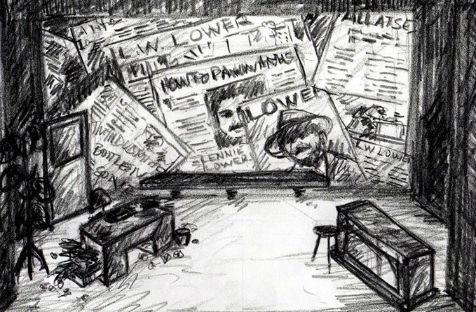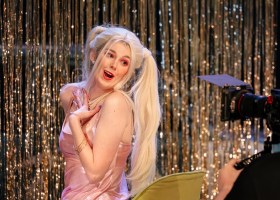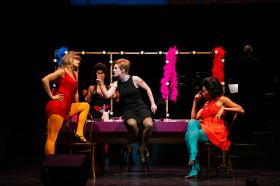The mere sight of Max Cullen’s parched white, make-up smudged face peeking beyond the curtain is enough to summon raucous laughter from the crowd at Canberra’s Street Theatre on Saturday 25 May, the opening night of the show How to be (or not to be) Lower.
Max Cullen and his channelling of one of the greatest comedic talents in Australia’s history is exemplary pairing. Cullen’s one man show depicting the turbulent biography of renowned humourist, Lennie Lower, is a dramatisation not only of the journalist’s life, but also a reference to the despair of the great depression and the fervent desire of newspapermen of the time to bring people joy in whatever form.
The set opens onto Lower’s disarrayed office, strewn with scrunched up balls of paper and bearing cartoonish markings that make the place look like a comic strip come to life. A projection screen at the back highlights various artefacts of the era, illuminating video footage and photographs from a time of despondency and desperation. Together with the evocative soundtrack filling Canberra’s Street One with the scratchy brassy sounds of the era, the mood is set for a trip down memory lane.
Cullen’s interpretation of Lower is one of a life blessed with luck and frazzled with calamity. The miraculous offer to Lower of a wage of 100 quid a week to produce a daily column in Frank Packer’s newspaper brought him fame and economic security in a time when both were scarce. Lower’s erratic temperament meant that his dealings with women and the bottle gave him an endless source of drama which fuelled his comedic inspiration. Cullen clutches onto these moments and makes them his own, typifying Lower with a comedic swagger and turbulence that makes it easy to understand why he is still treasured as a funny man genius.
Cullen also ventures into the more poignant moments of Lower’s life. Lower’s pharmacist father had run away from Adelaide to New South Wales to be with his 17 year old maid and in the excitement of Lower’s birth, had forgotten to register his son. As a consequence, Lower was never registered at birth, a trick of fate that served to his advantage when absconding from the army years later. As Cullen navigates through these more heartfelt moments of Lower’s life he seems unsure whether to treat them in the same slapstick nature as the rest of the play or really try to get to the core of Lower’s tumultuous upbringing.
As Cullen reels from scene to scene roiling for laughs like a clown on a unicycle, his characterisation of Lower appears more of a caricature than a personalisation. At times he appears unsure whether to portray Lower as a purely one-dimensional character whose life revolves around making fun of the mundane or whether to probe deeper into Lower’s life and extract the sensibilities that undoubtedly drove Lower as an individual. There are times when the troubles lurking behind Lower’s incessant need to please show their strain on the comedian and Cullen deals with these highs and lows with fine form, showing his innate skill as a stage actor. However, the disparate nature of the script means that the audience is not brought along the same journey to really understand and emphasise with the battles faced by Lower in his life.
While the production elements of the play are executed in style with the utilisation of props providing engaging action on the stage, the chaotic transgression of the story makes it difficult for the audience to fully relate to a person whose life is explored primarily in farcical snippets. The result is a tribute that impresses more as a parody of this man’s life than a well-rounded re-enactment of the complexities involved in Lower’s rise to the top. Cullen’s depiction of Lower is the culmination of a cleverly implemented piece backed by a professional backstage crew. With further refinement of the story to more fully explore the intricacies of Lower’s life, the play would have greater success in entertaining the audience in a more empathetic and compassionate manner.
Rated: 2.5
Venue: The Street Theatre, 15 Childers Street, Canberra City ACT 2601
Dates and times: 25 May to 1 June: Nightly 6:30pm for 7:30pm show; Sunday 26 June: 3pm for 4pm show
Tickets: Adult – $39.00; Concession – $36.00






